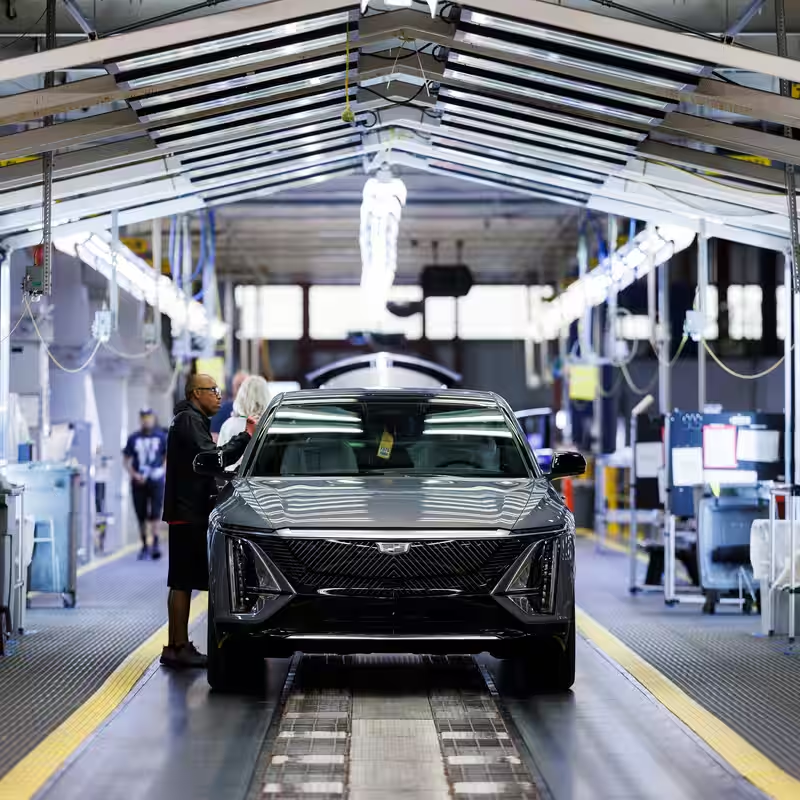Table of Contents
- GM’s Q3 Earnings: The Big Picture
- Why EV Costs Are Dragging GM Down
- Tariff Bill Lighter Than Feared
- Why Shares Jumped Despite Lower Profits
- What’s Next for GM’s EV Strategy?
- Sources
GM Profit Falls Sharply in Q3 Amid EV Headwinds
General Motors reported a steep drop in third-quarter profits—down more than 50% year-over-year—as the automaker grapples with slowing electric vehicle (EV) adoption and mounting production costs. Net income fell to $1.3 billion from $3 billion in the same period last year, even as total revenue held steady at $48.6 billion.
Yet, in a twist that surprised Wall Street, GM’s stock rose after the earnings release. Why? Investors weren’t focused on the headline profit decline—they were reassured by something else entirely.
Why EV Costs Are Dragging GM Down
GM’s electric vehicle segment has become a financial anchor rather than a growth engine. Once hailed as the cornerstone of CEO Mary T. Barra’s “all-electric future,” the EV business is now facing a harsh reality check.
“With the evolving regulatory framework and the end of federal consumer incentives, it is now clear that near-term EV adoption will be lower than planned,” Barra wrote in a letter to shareholders.
The company is now actively reassessing its EV manufacturing footprint, including potential delays or cancellations of planned battery plants. High raw material costs, complex supply chains, and softer-than-expected demand for models like the Chevrolet Blazer EV have all contributed to the slowdown.
Key Challenges Facing GM’s EV Push
- Declining federal tax credits for buyers
- High battery production costs
- Consumer hesitation amid charging infrastructure gaps
- Intensifying competition from Tesla and legacy rivals
Tariff Bill Lighter Than Feared
One bright spot in GM’s report: its tariff-related expenses for 2025 are coming in lower than analysts expected. While tariffs on imported auto parts—especially from China and Mexico—have been a persistent cost pressure, GM’s supply chain team appears to have mitigated some of the impact through strategic sourcing and inventory planning.
This “tariff relief” helped offset some of the EV losses and signaled stronger operational discipline to investors.
Why Shares Jumped Despite Lower Profits
Markets often look beyond quarterly earnings to forward guidance—and GM delivered. The company upgraded its full-year forecast for adjusted free cash flow and core automotive profitability, suggesting that underlying operations remain strong outside the EV segment.
“GM is showing it can manage through the EV transition without blowing up its balance sheet,” said Elena Torres, an auto analyst at Morgan Stanley. “That’s what investors care about right now.”
| Financial Metric | Q3 2024 | Q3 2025 | Change |
|---|---|---|---|
| Net Income | $3.0 billion | $1.3 billion | ↓ 57% |
| Revenue | $48.5 billion | $48.6 billion | ↔ Flat |
| Adjusted EBIT (Auto) | $3.2 billion | $3.4 billion | ↑ 6% |
What’s Next for GM’s EV Strategy?
GM isn’t abandoning EVs—but it’s hitting the brakes. The company plans to stretch its $35 billion EV investment over a longer timeline, prioritize high-margin models like the Cadillac Lyriq, and explore hybrid options to bridge the gap.
“We’re not walking away from electrification,” Barra emphasized. “We’re being pragmatic about the pace.”
That pragmatism may be exactly what the market wanted to hear. In an era of economic uncertainty and shifting consumer behavior, flexibility beats dogma—and GM seems to have gotten the message.




